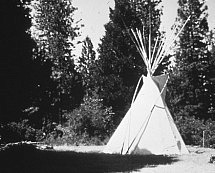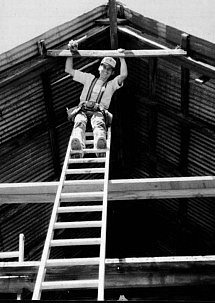The first dharma for the community was survival: learning how to create income, build shelter, provide food, and, most of all, work together for a larger goal.
Toward the end of the summer of 1969, it became clear to everyone that the community needed to think about housing for the winter, as well as income. Up to this point, Kriyananda had been supporting the retreat through his classes in San Francisco, and he was willing to continue to pay the mortgage payments. However, he wasn’t willing to continue subsidizing the living expenses of those people remaining on the land for the winter. Living in a cold climate was helpful as it forced people to confront basic realities! Several meetings were held about possible low cost housing solutions, along with ideas for producing income. For some the solution was to leave for the winter. Many of these never returned, because it was physically challenging and the novelty had worn off. Those who did return to stay had more seriousness of purpose, as nearly all of them wanted to learn Yoganandas teachings.
Sadhana Devi Helin:
We were a group of people with lots of energy, but not enough focus. Toward the end of the summer, it was obvious that we needed to think about the coming winter. In the foothills of the Sierras, it rains heavily, and even snows in the winter. We needed to think about shelter, not to mention ways to support ourselves. Several housing options were proposed, but the one that captured our imagination was the Native American tepee: simple, inexpensive, and even portable. Although I didn’t know how to build, I did know how to sew, and had purchased a book called The Indian Tipi, a comprehensive book on

Sadhana’s tepee
how to construct and live in a tepee such as the Sioux and Blackfoot Indians used. Some of us began to think that this could be the answer to our winter housing concerns; why not make it a group project? After receiving permission to cut lodgepole pine on public land near us, we organized our first cooperative work project. About 10-15 people went to the site, and camped for several days. There, one team cut 280 poles, then the second team stripped the bark from them. While we worked, others cooked, brought water, and ran any other errands we needed. When finished, we brought them back. It was quite a sight to see, there in the meadow, poles standing every which way, drying in the sun, waiting to be made into tepees. Later I sewed many of the canvas covers (12 of them!) and we began erecting the tepees. As you might imagine, there were many unforeseen details to be addressed, but some of us actually lived in the tepees for several years.
We learned much from our first work project; perhaps the most important lesson was

Vajra at Rajarsi Day 1980s
how much fun it was to work together. This began the tradition of Ananda cooperative workdays. Throughout the decades weve had hundreds of workdays or work weeks. Although much is accomplished, the real benefit is the sense of community that is fostered by these shared experiences; deepening progress toward a shared vision, an opportunity to serve, an expanded awareness. People of all skill levels are willing to do whatever job is needed. As someone once observed, people who are supervisors all week are quite happy to be workers on the weekend, and let others be the supervisors. We began to learn the principle of nishkam karma, or desireless action: to be less concerned with the outcome of ones activity, and to concentrate more on ones attitude while performing that activity, leaving the outcome in Gods hands. Therefore be conscientious during the performance of all actions, whether physical or spiritual, to act without attachment. By activity without self-interest, one attains the Supreme.Bhagavad Gita, (3:19)
In The Art of Supportive Leadership, Kriyananda says, Humility in leadership can be achieved also if one learns to view his role as a simple service to others. Indeed, this is the very essence of leadership: giving energy, not receiving it. And perhaps the surest way to ensure such an outward flow of energy is to think of oneself always as serving ones subordinates.[1]
